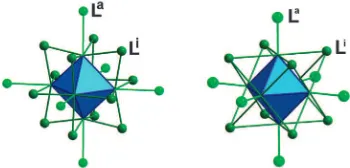This journal iscThe Royal Society of Chemistry and the Centre National de la Recherche Scientifique 2011 New J. Chem.,2011,35, 2245–2252 2245
Cite this:
New J. Chem
., 2011,
35
, 2245–2252
Octahedral niobium cluster-based solid state halides and oxyhalides:
effects of the cluster condensation
via
an oxygen ligand on electronic and
magnetic propertiesw
Bruno Fontaine,
aSte´phane Cordier,*
aRe´gis Gautier,*
aFakhili Gulo,
abJean-Franc¸ois Halet,
aBerislav Peric´
acand Christiane Perrin*
aReceived (in Montpellier, France) 29th April 2011, Accepted 1st June 2011
DOI: 10.1039/c1nj20377k
The influences of an oxygen ligand on the structural, magnetic and electronic properties of octahedral niobium cluster-based oxides and oxychlorides are reported. The Nb6metal cluster is edge-bridged by twelve inner ligands and additionally bonded to six apical ligands to form Nb6Li12La6units (L = Cl, O) wherein oxygen and chlorine are perfectly ordered. Oxygen favours the interconnection of clustersviadouble Oi–a/Oa–ibridges in a similar way to the double Si–a/Sa–ibridges found in Chevrel phases based on face capped Mo6L
i 8L
a
6units. Periodic density functional theory (DFT) calculations confirm that increasing the number of inner oxygen ligands at the expense of chlorine atoms favours the 14 metal-electron (ME) count per octahedral cluster unit. It is also shown that weak interactions occur between neighbouring clusters. Indeed, magnetic measurements performed on AxNb6Cl12O2(A = Rb,x= 0.816(8); A = Cs,x= 1)
series containing 15-ME species evidence antiferromagnetic interactions at low temperatures. Broken-symmetry DFT calculations of exchange parameters within spin dimer analysis confirm the experimental results.
Introduction
The termmetal atom cluster, introduced by F. A. Cotton in the early 1960’s, defines a finite group of metal atoms held together
via metal–metal bonds.1 Typical examples are found for octahedral nano-sized metallic clusters of transition elements which are easily obtained by solid state synthesis at high temperatures. They are associated with halogen or chalcogen ligands to form [(M6Li12)La6]n and [(M6Li8)La6]n units (a = apical, i = inner).2As sketched in Fig. 1, M6clusters are bonded to six terminal ligands (La) in both kinds of units but they are edge-bridged by twelve inner ligands (Li) in the [(M
6Li12)La6]n unit (M = Nb, Ta, W) and face-capped by eight inner ligands (Li) in the [(M6Li8)La6]n unit (M = Mo, W, Re). The intrinsic properties of M6cluster units—one- or two-electron reversible redox process, magnetism and luminescence—depend on the
nature of the metal and the ligands. The solubilisation of M6 solid state compounds provides [(M6Li12)La6]n or [(M6Li8)La6]n discrete building blocks in solution with specific physico-structural properties that can be used, via soft chemistry routes, in the design of hybrid organic/inorganic assemblies,3 organometallic stars and dendrimers,4–6 luminescent nano-particles,7,8 liquid crystals9,10 or coordination polymeric framework11–13as well as molecular junctions.14,15
The structures of niobium octahedral cluster halides are built up from either discrete or interconnected units in one, two or three directions of space (noted 1-, 2- and 3D respectively) by common La–a apical ligands (1-D: Cs2Nb6Br5F1216(Cs2Nb6Bri5Fi7Fa–a2/2Fa4according to the Scha¨fer notation),2 2-D: Li
2Nb6Cl16 (Li2Nb6Cli12Cla–a4/2Cl2),17 3-D: Nb6F15 (Nb6Fi12Fa–a6/2)18 and Na2NbF6–Nb6Fi12 xXixFa6 (X = Cl, Br)19,20series). In the Nb6L153-D compounds (Nb6Li12La–a6/2),
Fig. 1 Representation of edge-bridged (M6L i 12)L
a
6 (left) and
face-capped (M6Li8)La6(right) units.
aSciences Chimiques de Rennes, UMR 6226, CNRS—Universite´ de
Rennes 1-Ecole Nationale Supe´rieure de Chimie de Rennes, CS 50837, 35708 Rennes Cedex 7, France,
E-mail: rgautier@ensc-rennes.fr, stephane.cordier@univ-rennes1.fr, christiane.perrin@univ-rennes1.fr; Fax: +33 22323 8199; Tel: +33 22323 8122
b
Sriwijaya University, Department of Chemical Education, Palembang, Indonesia
c
Division of Materials Chemistry, Ru:er Bosˇkovic´ Institute,
Bijenicˇka cesta 54, HR-10000 Zagreb, Croatia
wWe dedicate this work to Didier Astruc on the occasion of his 65th birthday.
NJC
Dynamic Article Links
www.rsc.org/njc
PAPER
Downloaded by Iowa State University on 06 October 2011
Published on 01 July 2011 on http://pubs.rsc.org | doi:10.1039/C1NJ20377K
